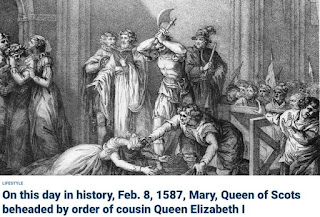Why Queen Elizabeth Beheaded Her Cousin Mary...world history and facts
Mary was Catholic, Elizabeth was Protestant and Mary wanted to be Queen of all Britain and make it Catholic again.
She was accused of planning a plot to assassinate her cousin. Mary was in prison for 19 years at Carlisle Castle, but lived like a Queen with 30 servants.
At the age of 44 Mary, Queen of Scots was beheaded for treason in the Great Hall of Fotheringhay Castle in England by order of her cousin, Queen Elizabeth I, on this day in history, Feb. 8, 1587.
Years later her Son became King, James the VI of Scotland and James I of all Britain. He was a Protestant and had the Bible translated into English.
James gave the translators instructions intended to ensure that the new version would conform to the ecclesiology, and reflect the episcopal structure, of the Church of England. He democratized the Bible, giving it to the common man.





.jpg)

.jpeg)






Comments
Post a Comment